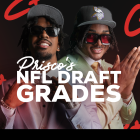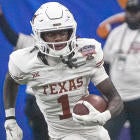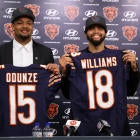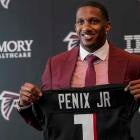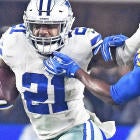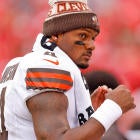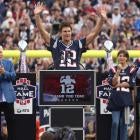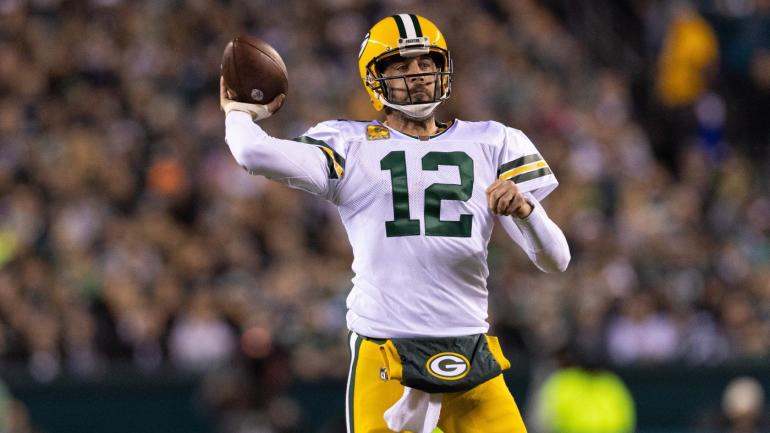
Aaron Rodgers isn't the first star quarterback in NFL history to switch teams late into his career. Whether teams choose to move on from their franchise quarterback or the franchise legend decides to move on, seeing future Hall of Fame quarterbacks in different uniform is one of the fascinating aspects in sports.
Can these quarterbacks have the same success with their new team as they did with their old one? Does getting that future Hall of Fame quarterback elevate that franchise and make them Super Bowl contenders?
Rodgers will be the latest quarterback to test those waters, as he was traded to the New York Jets after 18 years with the Green Bay Packers. He has some good history to look back on, as plenty of future Hall of Fame quarterbacks shined with their next team.
Here's a review of all the great quarterbacks to switch teams at the end of their career. To qualify for these rankings, these quarterbacks have to be 35 or over or spent 10-plus years with one franchise by the time they switched teams.
9. Johnny Unitas (Los Angeles Chargers)
One of the greatest quarterbacks ever was on the downturn of his career after his 1967 MVP season, as Unitas was relegated to a backup after leading the Baltimore Colts to a win in Super Bowl V (1970 season). Unitas was traded to the Chargers fo future considerations in 1973, having to sever a personal services contract that would have paid him $300,000 over 10 years from the Colts once he retired.
The Chargers needed just four games to realize their mistake, as Unitas was benched for Dan Fouts after completing just 44.7% of his passes for 471 yards with three touchdowns to seven interceptions (40.0 rating).
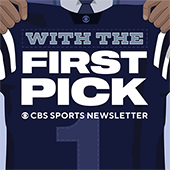
With The First Pick Newsletter
With The First Pick Newsletter
Prepare for the upcoming NFL Draft with the day’s big stories + mock drafts, big board updates and more.
Thanks for signing up!
Keep an eye on your inbox.
Sorry!
There was an error processing your subscription.
Unitas threw just one more pass in the NFL after his benching.
8. Joe Namath (Los Angeles Rams)
Namath's 30s were not kind to him as his days as one of the best deep ball throwers in the NFL were waning. He threw 66 interceptions to just 39 touchdown passes in his last three years with the Jets before parting ways in 1977, signing with the Rams.
Namath lasted just four starts in Los Angeles, completing just 46.7% of his passes or 606 yards with three touchdowns to five interceptions (54.5 rating). The Rams went 2-2 in those starts as Namath was benched for Pat Haden -- who led Los Angeles to their fifth consecutive NFC West title.
Namath never played another NFL game.
7. Ken Stabler (Houston Oilers, New Orleans Saints)
A decade of success with the Oakland Raiders wasn't enough for the franchise to retain Stabler, as they traded him to the Houston Oilers in 1980 for Dan Pastorini in a famous quarterback-for-quarterback swap. Stabler wasn't as successful with the Oilers, completing 61.7% of his passes for 5,190 yards with 27 touchdowns to 46 interceptions in two seasons (69.0 rating). The Oilers were 16-12 in Stabler's starts before he was released.
Stabler signed with the Saints to be the backup quarterback for Archie Manning, but Manning was traded in September of 1982 and Stabler ended up as the starter. He completed 57.2% of his passes in three years with New Orleans, throwing for 3,670 yards with 17 touchdowns to 33 interceptions (62.4 rating). The Saints were 11-11 in his 22 starts.
6. Warren Moon (Minnesota Vikings, Seattle Seahawks)
One of the premier free agents in 1994 (at the age of 38), Moon signed with the Vikings after 10 seasons and six consecutive Pro Bowls with the Houston Oilers. Moon hade three Pro Bowls in four seasons since leaving Houston, throwing for 4,000 yards in each of his first two seasons with the Vikings. Moon only played in one playoff game in his five seasons starting with the Vikings and Seahawks -- who he signed as a free agent with in 1997.
Moon went 32-31 in his five seasons with both teams, throwing for 94 touchdowns to 66 interceptions. He made three Pro Bowls after the age of 38, including one at 41.
5. Brett Favre (New York Jets, Minnesota Vikings)
Favre's exit from the Packers was well publicized when he decided to un-retire and return to the NFL in 2008. He was traded to the Jets in August of that year, getting the team off to an 8-3 start before a torn biceps tendon led to a collapse that cause New York to miss the playoffs. Favre did make the Pro Bowl that season, completing 65.7% of his passes for 3,472 yards with 22 touchdowns to 22 interceptions (81.0 rating).
He signed with the Vikings in 2009 and took Minnesota to the NFC Championship Game, finishing fourth in NFL MVP voting after completing 68.4% of his passes for 4,202 yards with 33 touchdown passes to seven interceptions (107.2 rating) -- arguably the best season of his career at the age of 40.
Favre retired after the 2010 season, an injury-riddled year which he threw 11 touchdowns to 19 interceptions.
4. Joe Montana (Kansas City Chiefs)
Montana ended the legacy of Super Bowl-winning and/or future Hall of Fame quarterbacks having poor endings with different teams in their mid-to-late 30s. Traded to the Chiefs after the San Francisco 49ers moved on to Steve Young after the 1992 season. Montana still had some good football left in him.
The Chiefs tailored the offense to Montana, hiring offensive coordinator Paul Hackett (Montana's former quarterbacks coach in San Francisco) and installed the West Coast offense. The Chiefs won their division for the first time in 22 years as Montana threw for 2,144 yards, 13 touchdowns to seven interceptions for an 87.4 passer rating at 37 years old.
Kansas City fell in the AFC Championship Game to the Buffalo Bills, winning more postseason games in the 1993 season than the previous 24 seasons. Montana went to his final Pro Bowl in 1993. The 1994 season was Montana's final year in the NFL, guiding the Chiefs to a 9-7 record and finishing with 3,283 yards with 16 touchdowns, nine interceptions and and an 83.6 passer rating at age 38.
Montana retired after the 1994 season, going 17-8 in his two seasons in Kansas City.
3. Peyton Manning (Denver Broncos)
Manning had plenty of game left after becoming the highest-profile free agent in NFL history. Signing with Broncos in 2012, Manning won the 2013 NFL MVP at the age of 37 -- setting the NFL record for touchdown passes in a season (55) and passing yards in a season (5,477).
He finished in the top two of league MVP voting in his first two seasons and led the NFL in completion percentage in 2012. Manning capped off his four years with the Broncos by leading the team to a victory in Super Bowl 50, even if he wasn't the Hall of Fame passer that he was from 1998 through 2014.
In Manning's four years with the Broncos, he went 45-12 in 57 starts with 140 touchdowns to 53 interceptions and a 101.7 passer rating. The Broncos won four AFC West titles and made two Super Bowls. manning was the first quarterback to win two Super Bowls with two different teams.
2. Norm Van Brocklin (Philadelphia Eagles)
Van Brocklin actually retired from the NFL in 1957, not wanting to play for Los Angeles Rams coach Sid Gillman anymore. Retirement wasn't in the cards for Van Brocklin, who admitted he didn't want to go to the Eagles (but playing was better than not playing). He also enjoyed the prospect of playing for Eagles coach Buck Shaw.
Van Brocklin capped off a career better than any quarterback, winning the 1960 NFL MVP and leading the Eagles to the NFL championship -- the only team to give Vince Lombardi a playoff loss. He made the Pro Bowl all three years and was responsible for turning the Eagles into a championship contender.
Not having the dominance Manning did, Van Brocklin ended his playing career better than any player in league history.
1. Tom Brady (Tampa Bay Buccaneers)
Two decades with the New England Patriots resulted in six Super Bowl titles for Brady, who parted ways with Bill Belichick and the only professional franchise he ever played for in search for a new team. He settled on Tampa Bay and proved to the Patriots he was far from finished, winning the Super Bowl in year one with the Buccaneers and Super Bowl LV MVP.
The second quarterback to win a Super Bowl with two different teams (and the first two win it in two different conferences), Brady threw for 4,000 yards in all three seasons with the Buccaneers. Brady threw for 108 touchdowns to just 33 interceptions with the Buccaneers (98.1 rating), throwing 40 touchdowns in consecutive positions.
Brady deserves the top spot here, just by winning the Super Bowl -- and MVP -- in his first season with his new team.














